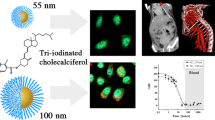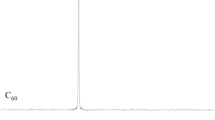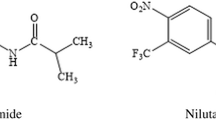Abstract
19F NMR spectroscopy was used to determine quantitatively the organ distribution and organ retention time in rats of the mixed fluorocarbon–hydrocarbon dowel molecule C6F13CH = CHC10H21 (F6H10E), which stabilizes highly concentrated injectable fluorocarbon emulsions destined for in vivo oxygen transport and delivery. The only fluorine resonances detected in the 19F NMR spectra of the organs analyzed were those of the F6H10E dowel itself, indicating that metabolites, if present, have very low concentrations (<10−4 M, limit of our assay). The F6H10E content in the liver peaked 1 day after administration (7 days for the spleen). At a dose of 3.6 g/kg body weight, the half-life of F6H10E in the liver was 25 ± 5 days.
Similar content being viewed by others
REFERENCES
J. G. Riess. Overview of progress in the fluorocarbon approach to in vivo oxygen delivery. Proc. Int. Symp. Blood Subst., Montreal, 1991. Biomat. Art. Cells Immob. Biotech. 20:183–204 (1992).
J. G. Riess. Fluorocarbon-based in vivo oxygen transport and delivery systems. Vox Sang. 61:225–239 (1991).
N. S. Faithfull. Oxygen delivery from fluorocarbon emulsions—Aspects of convective and diffusive transport. Biomat. Art. Cells Immob. Biotech. 20:797–804 (1992).
D. C. Long, D. M. Long, J. G. Riess, R. Follana, A. Burgan, and R. F. Mattrey. Preparation and application of highly concentrated perfluorooctyl bromide fluorocarbon emulsions. In T. M. S. Chang and R. P. Geyer (eds.), Blood Substitutes, Marcel Dekker, New York, 1989, pp. 441–442.
J. G. Riess and M. Postel. Stability and stabilization of fluorocarbon emulsions destined for injection. Biomat. Art. Cells Immob. Biotech. 20:819–830 (1992).
J. G. Riess, L. Solé Violan, and M. Postel. A new concept in the stabilization of injectable fluorocarbon emulsions: The use of mixed fluorocarbon-hydrocarbon dowels. J. Disp. Sci. Technol. 13:349–355 (1992).
K. Yokoyama, K. Yamanouchi, and R. Murashima. Excretion of perfluorochemicals after intravenous injection of their emulsion. Chem. Pharm. Bull. 23:1368–1373 (1975).
K. Yamanouchi, R. Murashima, and K. Yokoyama. Determination of perfluorochemicals in organs and body fluids by gas chromatography. Chem. Pharm. Bull. 23:1363–1367 (1975).
J. Lutz and M. Stark. Half-life and changes in the composition of a perfluorochemical emulsion within the vascular system of rats. Pflügers Arch. 410:181–184 (1987).
M. Watanabe, S. Hanada, K. Yano, K. Yokoyama, T. Suyama, and R. Naito. Long-term survival of rats severely exchange-transfused with Fluosol-DA. In Proceedings of the 4th International Symposium on Perfluorochemical Blood Substitution (Kyoto, October 1978), Elsevier Excerpta Medica, Amsterdam, 1979, pp. 347–357.
R. P. Geyer. Fluorocarbon-polyol artificial blood substitutes. N. Engl. J. Med. 289:1077–1082 (1973). (b) Y. Tsuda, K. Yamanouchi, K. Yokoyama, and T. Suyama. Discussion and considerations for the excretion mechanism of perfluorochemical emulsion. In T. M. S. Chang and R. P. Geyer (eds.), Blood Substitutes, Marcel Dekker, New York, 1988, pp. 473–483.
V. V. Obraztsov, A. S. Kabalnov, and K. N. Makarov. A novel model describing the excretion of perfluorochemicals from living organisms: dissolutions of fluorocarbons in lipid components of blood. J. Fluorine Chem. 54:376 (1991).
J. G. Riess. Reassessment of criteria for the selection of perfluorochemicals for second generation blood substitutes. Analysis of structure/property relationships. Art. Org. 8:44–56 (1984). (b) R. E. Moore and L. C. Clark. Synthesis and physical properties of perfluorocompounds useful as synthetic blood candidates. In R. Frey, H. Beisbarth, and K. Stosseck (eds.), Proceedings of the 5th International Symposium on Oxygen-Carrying Colloidal Blood Substitutes (Mainz, March 1981), W. Zuckschwerdt. Verlag Munich, 1982, pp. 50–60.
K. Yamanouchi, M. Tanaka, Y. Tsuda, K. Yokohama, S. Awazu, and Y. Kobayashi. Quantitative structure-in vivo half-life relationships of perfluorochemicals for use as oxygen transporters. Chem. Pharm. Bull. 33:1221–1231 (1985).
G. Gregoriadis. Liposomes as Drug Carriers. Recent Trends and Progress, Wiley, Chichester, 1988. (b) A. Wretlind. Current status of intralipid and other fat emulsions. In H. C. Meng and D. W. Wilmore (eds.), Fat Emulsions in Parenteral Nutrition, American Medical Association, Chicago, IL. 1976, pp. 109–122.
J. G. Riess, C. Cornelus, M. P. Krafft, A. M. Mahé, M. Postel, and L. Zarif. Novel fluorocarbon-based injectable oxygen-carrying formulations with long-term room-temperature storage stability. In P. Vaupel (ed.), Oxygen Transport to Tissues XV, Plenum, New York (in press).
M. C. Malet-Martino, D. Betbeder, A. Lattes, A. Lopez, R. Martino, G. Francois, and S. Cros. Fluosol 43 intravascular persistence in mice measured by 19F NMR. J. Pharm. Pharmacol. 36:556–559 (1984).
P. S. Tofts and S. Wray. A critical assessment of methods of measuring metabolite concentrations by NMR spectroscopy. NMR Biomed. 1:1–10 (1988).
N. O. Brace. Relative reactivities and stereochemistry of addition of iodoperfluoroalkanes to cyclic olefins. J. Org. Chem. 37:2429–2433 (1972).
M. Le Blanc, J. G. Riess, D. Poggi, and R. Follana. Use of lymphoblastoïd Namalva cell cultures in a toxicity test. Application to the monitoring of detoxification procedures for fluorocarbons to be used as intravascular oxygen carriers. Pharm. Res. 3:246–248 (1985).
M. P. Krafft, J. P. Rolland, and J. G. Riess. Detrimental effect of excess lecithin on the stability of fluorocarbon/lecithin emulsions. J. Phys. Chem. 95:5673–5676 (1991).
Y. Tsuda, K. Yamanouchi, H. Okamoto, K. Yokoyama, and C. Heldebrant. Intravascular behavior of a perfluorochemical emulsion. J. Pharmacobio-Dyn. 13:165–171 (1990).
B. I. Islamov, Iu V. Ladilov, V. A. Buevich, and R. V. Bobrovskioi. An emulsion of fluorocarbons as a protective agent against myocardial ischemia. Vestn. Akad. Med. Nauk. SSSR 3:39–43 (1991).
Y. Tsuda, K. Yamanouchi, K. Yokoyama, and T. Suyama. Discussion and considerations for the excretion mechanism of perfluorochemical emulsion. In T. M. S. Chang and R. P. Geyer (eds.), Blood Substitutes, Marcel Dekker, New York, 1989.
Author information
Authors and Affiliations
Rights and permissions
About this article
Cite this article
Zarif, L., Postel, M., Septe, B. et al. Biodistribution of Mixed Fluorocarbon–Hydrocarbon Dowel Molecules Used as Stabilizers of Fluorocarbon Emulsions: A Quantitative Study by Fluorine Nuclear Magnetic Resonance (NMR). Pharm Res 11, 122–127 (1994). https://doi.org/10.1023/A:1018914215345
Issue Date:
DOI: https://doi.org/10.1023/A:1018914215345




